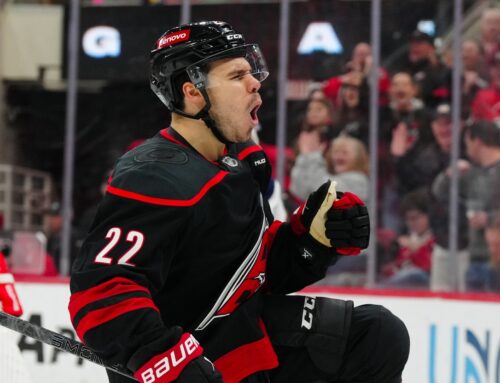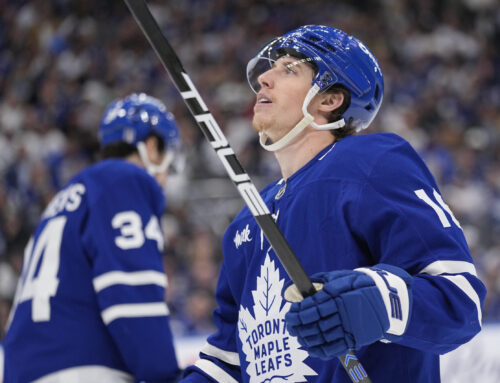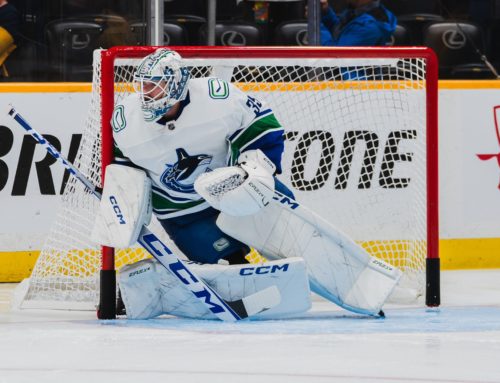
One contract that many hockey fans were curious about was finalized on Saturday, as the St. Louis Blues signed Jordan Binnington to a two-year contract with an average annual value of $4.4 million.
Since the 26-year-old Binnington went from fourth-string goalie and midseason callup to Calder Trophy finalist and Stanley Cup champion, there wasn’t much of a template for what this contract should look like. Matt Murray’s three-year contract with an AAV of $3.75 million following his first Stanley Cup win (2016) was considered a possible example. Comparing the two, Binnington received a larger AAV while receiving a shorter term, perhaps because he is older than Murray was and didn’t enter the league with the pedigree that Murray did. If Binnington’s play falls off, the Blues are only locked in for two seasons.
As it turns out, according to Cap Friendly, Petr Mrazek’s 2016 contract and Jonathan Bernier’s 2015 contract were closer examples to Binnington’s contract than Murray’s was.
Jordan Binnington
2 years x $4.4M AAV#BluesMost comparable contracts:
1. Petr Mrazek
2. Jonathan Bernier
3. Matt Murray
4. Robin Lehnerhttps://t.co/jqVn5t2Mjx pic.twitter.com/t8E4iJZSca— CapFriendly (@CapFriendly) July 14, 2019
There’s certainly lots of debate as to whether Binnington is the real thing or simply a flash-in-the-pan that went on a hot streak for half a season. There’s no guarantee that Binnington will continue this run, and in all likelihood he will cool off to some degree. However, it would be hasty to assume that he will be another Andrew Hammond, as he had posted an impressive 2.06 GAA and .926 SV% over his past two AHL seasons (44 GP) leading up to his recent NHL success. I’m not ranking him as a top-tier goalie in drafts this fall (although I’m sure someone might), although I would consider him as a low G1/high G2 in 12-team standard-size roto leagues.
*
Fantasy Guide lowdown votes are back again this year! Dobber will write an expanded profile on one player from each team that receives the most votes. You can vote in the Forum on the following teams (note that these polls are time sensitive):
Columbus – I voted for Cam Atkinson because I’m interested in what Dobber has to say about him without Artemi Panarin (although I think I already know). Oliver Bjorkstrand is the leader at the time of writing, though, since many want to know if a breakout is coming.
Colorado – I voted for Tyson Jost for purely selfish reasons – he’s a keeper of mine. Surprisingly, he’s the leader at the time of writing (I thought Nazem Kadri or would be). After two largely meh seasons, can Jost take it to another level in his third full NHL season? If I could give a second vote, it would be to newly acquired Joonas Donskoi, since he’ll be a bubble keeper of mine as well.
So far, the winners from each team are:
ANA: Troy Terry
ARI: Nick Schmaltz
BOS: Jake DeBrusk
BUF: Casey Mittelstadt
CGY: Noah Hanifin
CAR: Andrei Svechnikov
CHI: Dylan Strome
*
This news fell under the radar a bit, but Slava Voynov has signed a one-year contract for $1.1 million with Avangard of the KHL (Igor Eronko). If he signs with an NHL team, Voynov would still need to serve the remaining 41 games of his NHL suspension.
Also from Eronko’s Twitter account: Both Sven Andrighetto and Ty Rattie have signed in the KHL. Rattie signed for one year with Lokomotiv (where his coach will be Craig MacTavish), while Andrighetto has signed for two years with Avangard. With all that discussion about Rattie as a possible sleeper because of his potential to slip onto a line with Connor McDavid, his NHL season career high has been a meager 11 points. Much ado about nothing.
*
Leagues come in all shapes and sizes when it comes to the number of teams, roster sizes, and keeper allowances. Leading up to Bubble Keeper Week, I’ll cover players that don’t fit the criteria of Bubble Keeper Week. However, these are players that I need to make a decision on anyway, since one of my leagues allows only four keepers (including one goalie).
I’ll start with a player who experienced a major production boost after being traded in the offseason. Will the new value be permanent?
During last year’s offseason, the debate was which new acquisition would line up with Johnny Gaudreau and Sean Monahan: James Neal or Lindholm? Many fantasy owners thought it would be the more established Neal; however, Lindholm was picked and turned out to be the right choice. He turned out to be a near point-per-game player (0.96 PTS/GP), while the Flames already have to be regretting the Neal signing (19 points in 63 games).
Lindholm set a new career high in goals (27), which resulted from a career high in shots (182) and shooting percentage (14.8%). He also set a career high in assists (51), which resulted from him spending nearly three-quarters of his even-strength time with Gaudreau and Monahan. We can probably assume he’ll stay on this line, which means that his production shouldn’t dip back to what it was during his Carolina days (40-45 points), where he was used all over the place.
Lindholm’s 5-on-5 shooting percentage of 10.39% is slightly higher than expected, but it doesn’t signal a massive regression. If that shooting percentage dips to his career average with his current shot total, he should be looking at just over 20 goals in 2019-20. Another area of concern, though, was the fact that Lindholm ended the season with just two goals over his last 24 games. I’d bet the under on him scoring 27 goals again.
His assist total could actually remain constant, since his primary and secondary assist totals were very similar. His IPP of 61.9% doesn’t suggest much of a drop, either. He should also continue to rack up the power-play points, another stat in which he reached his career high (26 PPP) while on the first unit.
Overall, Lindholm should continue to slot in as an effective playmaker on the Flames’ top line and first power-play unit. However, that production should be fairly assist-heavy going forward, as I see him reaching about 20 goals and 50 assists in 2019-20. That doesn’t mean he won’t be an effective fantasy option, just that if you had to choose between two players with similar point totals, the advantage (everything else remaining equal) would be with the player with the higher goal total, since goals are harder to come by than assists. Maybe someone like the next guy?
On a team that is in the middle of its rebuild, Larkin is clearly its strongest offensive weapon. His 73 points (32g-41a) was nearly 20 points ahead of the next highest-scoring Red Wing (Andreas Athanasiou). Larkin helped his cause by shooting the puck a ton, as his 287 SOG ranked him within the top 10. Larkin also provided some hidden value in the penalty minutes category, as his 75 PIM was also the highest on the team.
Larkin’s value suffered in the power-play-points category. Not because he doesn’t play on the first-unit power play, but because his team-leading 15 PPP was barely within the NHL’s top 100. In comparison, Lindholm’s value was boosted by his 26 PPP, which was within the top 30. This is where Larkin suffers from playing on a team that simply doesn’t boast the high-end scoring talent that it used to.
In order to reach 30+ goals again, Larkin will need to continue shooting the puck. As the Wings’ number one scoring option, there’s a strong possibility that he will continue to do that. A slight decrease in shots combined with a dip in shooting percentage (11.1% in 2018-19, 9.2% career) could mean that he finishes with something in the area of 25 goals.
On the other hand, Larkin’s assist total could increase in 2019-20. His 41 assists in 2018-19 was six below his career high set the previous season. His 26 primary assists compared to his 15 secondary assists should also indicate that his 40+ assists aren’t happening simply because he is in the right place at the right time.
On one hand, Larkin’s value could be higher on a team where he has more scoring options around him. However, he is clearly the guy in the Motor City when it comes to scoring. His 21:51 of overall icetime was only seven seconds behind team leader Danny DeKeyser. It’s rare that a forward receives this much icetime relative to a team’s top four defensemen. Expect his 2019-20 production to be relatively consistent when compared to what he generated in 2018-19.
*
Look for the July edition of the Top 100 Roto Rankings to be posted on Monday. In the meantime, here are the June rankings.
For more fantasy hockey information, or to reach out to me directly, you can follow me on Twitter @Ian_Gooding.





 CAR
CAR WPG
WPG PHI
PHI ANA
ANA BUF
BUF CHI
CHI T.B
T.B
 L.A
L.A COL
COL
